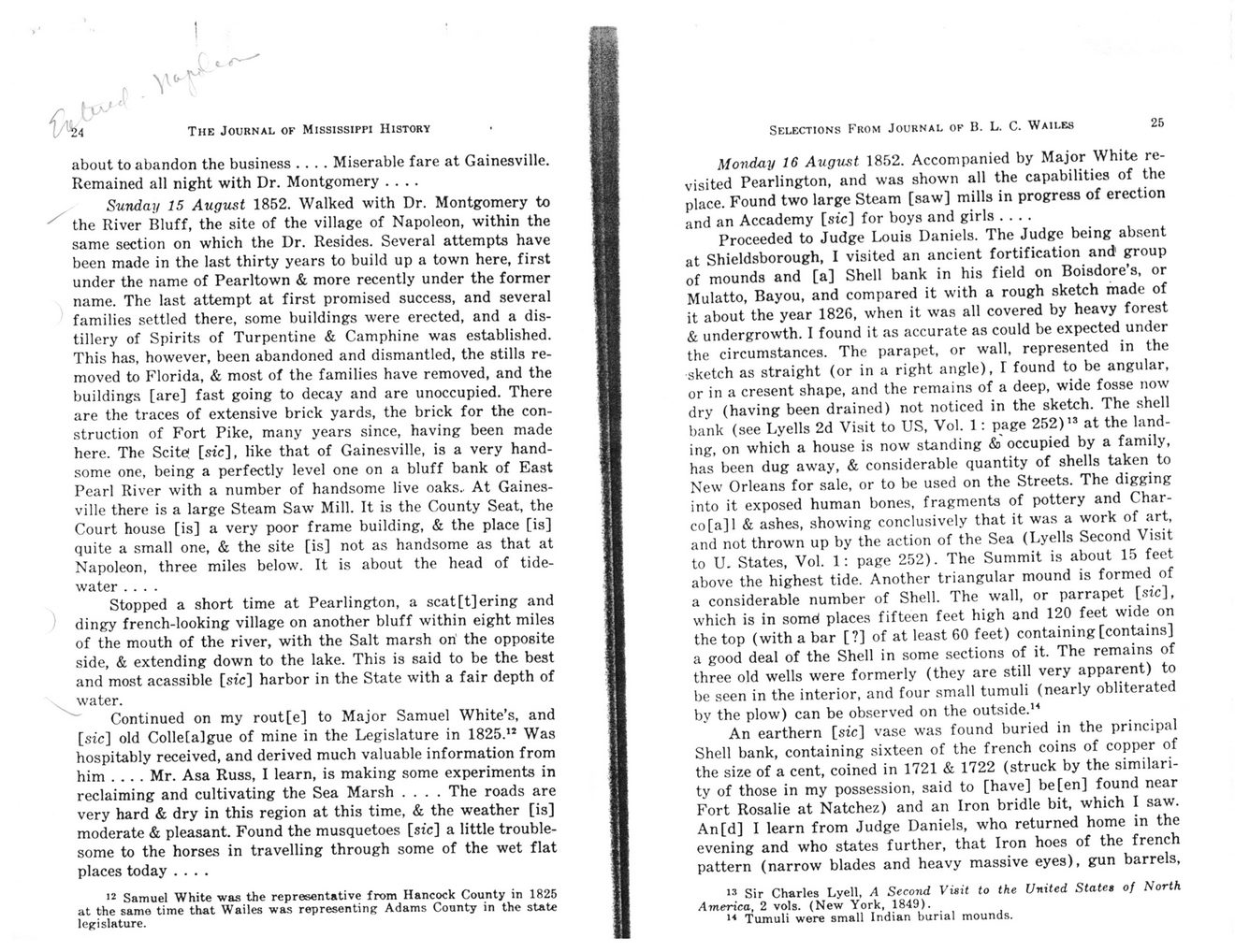This text was obtained via automated optical character recognition.
It has not been edited and may therefore contain several errors.
’A The Journal of Mississippi History about to abandon the business .... Miserable fare at Gainesville. Remained all night with Dr. Montgomery .... Sunday 15 August 1852. Walked with Dr. Montgomery to the River Bluff, the site of the village of Napoleon, within the same section on which the Dr. Resides. Several attempts have been made in the last thirty years to build up a town here, first under the name of Pearltown & more recently under the former name. The last attempt at first promised success, and several families settled there, some buildings were erected, and a distillery of Spirits of Turpentine & Camphine was established. This has, however, been abandoned and dismantled, the stills removed to Florida, & most of the families have removed, and the buildings [are] fast going to decay and are unoccupied. There are the traces of extensive brick yards, the brick for the construction of Fort Pike, many years since, having been made here. The Scite1 [sic], like that of Gainesville, is a very handsome one, being a perfectly level one on a bluff bank of East Pearl River with a number of handsome live oaks.. At Gainesville there is a large Steam Saw Mill. It is the County Seat, the Court house [is] a very poor frame building, & the place [is] quite a small one, & the site [is] not as handsome as that at Napoleon, three miles below. It is about the head of tidewater .... Stopped a short time at Pearlington, a scat[t]ering and ) dingy french-looking village on another bluff within eight miles of the mouth of the river, with the Salt marsh on the opposite side, & extending down to the lake. This is said to be the best and most acassible [sic] harbor in the State with a fair depth of water. Continued on my rout[e] to Major Samuel White’s, and [sic] old Colle[a]gue of mine in the Legislature in 1825.12 Was hospitably received, and derived much valuable information from him .... Mr. Asa Russ, I learn, is making some experiments in reclaiming and cultivating the Sea Marsh .... The roads are very hard & dry in this region at this time, & the weather [is] moderate & pleasant. Found the musquetoes [sic] a little troublesome to the horses in travelling through some of the wet flat places today .... 12 Samuel White was the representative from Hancock County in 1826 at the samo time that Wailes was representing Adams County in the state legislature. Selections From Journal ok B. L. C. Waii.es 26 Monday 16 August 1852. Accompanied by Major White revisited Pearlington, and was shown all the capabilities of the place. Found two large Steam [saw] mills in progress of erection and an Accademy [sic] for boys and girls .... Proceeded to Judge Louis Daniels. The Judge being absent at Shieldsborough, I visited an ancient fortification and1 group of mounds and [a] Shell bank in his field on Boisdore’s, or Mulatto, Bayou, and compared it with a rough sketch made of it about the year 1826, when it was all covered by heavy forest & undergrowth. I found it as accurate as could be expected under the circumstances. The parapet, or wall, represented in the sketch as straight (or in a right angle), I found to be angular, or in a cresent shape, and the remains of a deep, wide fosse now dry (having been drained) not noticed in the sketch. The shell bank (see Lyells 2d Visit to US, Vol. 1: page 252)13 at the landing, on which a house is now standing & occupied by a family, has been dug away, & considerable quantity of shells taken to New Orleans for sale, or to be used on the Streets. The digging into it exposed human bones, fragments of pottery and Char-co[a]l & ashes, showing conclusively that it was a work of art, and not thrown up by the action of the Sea (Lyells Second Visit to U. States, Vol. 1: page 252). The Summit is about 15 feet above the highest tide. Another triangular mound is formed of a considerable number of Shell. The wall, or parrapet [sic], which is in somd places fifteen feet high and 120 feet wide on the top (with a bar [?] of at least 60 feet) containing [contains] a good deal of the Shell in some sections of it. The remains of three old wells were formerly (they are still very apparent) to be seen in the interior, and four small tumuli (nearly obliterated by the plow) can be observed on the outside.” An earthern [sic] vase was found buried in the principal Shell bank, containing sixteen of the french coins of copper of the size of a cent, coined in 1721 & 1722 (struck by the similarity of those in my possession, said to [have] be[en] found near Fort Rosalie at Natchez) and an Iron bridle bit, which I saw. An[d] I learn from Judge Daniels, who returned home in the evening and who states further, that Iron hoes of the french pattern (narrow blades and heavy massive eyes), gun barrels, 13 Sir Charles Lyell, A Second Visit to the United States of North America, 2 vols. (New York, 1849). 14 Tumuli were small Indian burial mounds.

Gainesville Benjamin-Wailes-1852-4